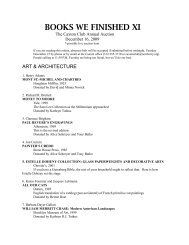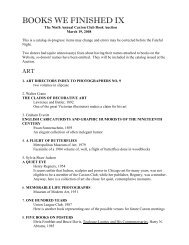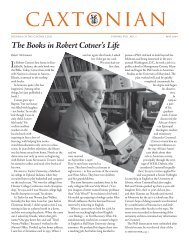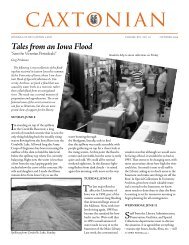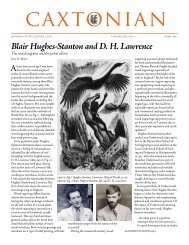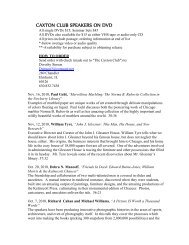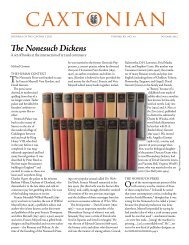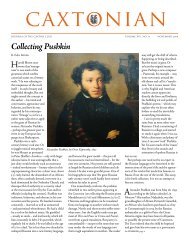Easter Egg Chickens - The Caxton Club
Easter Egg Chickens - The Caxton Club
Easter Egg Chickens - The Caxton Club
You also want an ePaper? Increase the reach of your titles
YUMPU automatically turns print PDFs into web optimized ePapers that Google loves.
to fight against the Viet Cong.6 Did Lyndon<br />
Johnson read that issue?<br />
My friend Larry Richmond had a set of<br />
National Geographic magazines going<br />
back to the 1940s. Larry was just my age.<br />
When we first moved to Pearl River, he and<br />
his family lived in a little house directly across<br />
the street. But in the early 1960s, they built a<br />
split-level home on the wooded lot next door.<br />
Larry’s father, Gil, had started collecting the<br />
magazines before World War II. <strong>The</strong>y must<br />
have inspired him to explore. He kept a shortwave<br />
radio set in the basement of the new<br />
house, spending hours talking to people he’d<br />
never met about things that didn’t seem very<br />
interesting. His main goal was to reach people<br />
from as far away as possible. He noted their<br />
names, locations, and call letters in a little<br />
book he kept next to the radio set.<br />
<strong>The</strong> Richmonds’ new house didn’t really<br />
have an attic. Instead, it had something called<br />
a “crawl space” under the pitched roof, good<br />
for storing things but too low to stand in. <strong>The</strong><br />
door to the crawl space opened into Larry’s<br />
bedroom. <strong>The</strong> old National Geographics were<br />
stacked in boxes behind that door. Apparently<br />
Gil Richmond had refused to make what<br />
author Neil Genzlinger has called “the hardest<br />
decision many of us will ever have to make . . .<br />
the decision to throw out those old National<br />
Geographics.”7 I certainly had kept all of mine,<br />
because they did not date. A 40-year-old issue<br />
was as interesting as the one just delivered to<br />
my mailbox. I even had hopes – never realized<br />
– of one day putting all of my copies in<br />
the leatherette binders the Society offered its<br />
members to protect their collections.<br />
What they say about the National Geographic<br />
is, of course, quite true.<br />
As a New Yorker writer put it in a 1943<br />
profile of Gilbert Grosvenor:<br />
[T]o judge from their letters, Geographic<br />
readers look with favor upon Grosvenor’s<br />
policy of running a good many pictures of<br />
lightly clad young people, generally of the<br />
colored races in far-off lands. Grosvenor<br />
knows that the Geographic is read by a great<br />
many ladies, so, in addition to pictures of girls,<br />
he makes a point of running occasional photographs,<br />
or paintings, of handsome young<br />
men, some of whom, being natives of tropical<br />
regions, are dressed in next to nothing.8<br />
Or, as Grosvenor himself noted in the magazine’s<br />
seventy-fifth anniversary issue, October<br />
1963: “National Geographic never dressed tribal<br />
tured them in their natural state.”9<br />
I already had some idea of that from the<br />
subscription my aunt had given me. My first<br />
year alone, 1961, offered several examples<br />
of the magazine’s freedom from prudery in<br />
articles about Panama, Haiti, New Britain<br />
(in New Guinea, not Connecticut!), and<br />
Brazil. <strong>The</strong> article on Brazil really grabbed my<br />
attention: “Blue-eyed Indian – A City Boy’s<br />
Sojourn with Primitive Tribesmen in Central<br />
Brazil.” It was about an eight-year-old boy<br />
named Alexander Schultz, son of a German<br />
anthropologist, who spent his summer vacation<br />
with his father living among the Javahé<br />
people in a jungle about 1,000 miles west of<br />
Salvador da Bahia. <strong>The</strong> article told how he<br />
learned to shoot a bow and arrow and to fish<br />
for piranhas. How he wore a feathered headdress<br />
and body paint. How he ate turtle eggs<br />
raw with sugar and found them delicious.<br />
According to the article, the boy shed both<br />
his inhibitions and his name; he was known<br />
to the Javahé only as “Teemaree.” Neither the<br />
tribe, nor the father, nor the son was very<br />
prudish.<br />
So when we found the cache of old National<br />
Geographics in Larry Richmond’s crawl space,<br />
we immediately started combing them for<br />
articles and illustrations of interest. <strong>The</strong> newer<br />
issues were filled mostly with color photos<br />
taken with Kodachrome and Ektachrome<br />
film – the magazine always made a point of<br />
telling you which, without telling you why it<br />
mattered, other than as not-so-subtle endorsements<br />
for Kodak products. <strong>The</strong> older issues<br />
used other technologies, such as Autochrome,<br />
Finlay, and Dufaycolor photography as well as<br />
color paintings.<br />
Originally, there were no color illustrations<br />
at all. <strong>The</strong> first issue of the National<br />
Geographic rolled off the press in 1888, the year<br />
the Society was founded. <strong>The</strong> Society’s first<br />
president, Gardiner Greene Hubbard, was<br />
a wealthy Boston lawyer with a wide range<br />
of interests. He had four daughters, one of<br />
whom, named May, became deaf after a childhood<br />
bout with scarlet fever. Hubbard’s search<br />
for a teacher who could restore her ability to<br />
speak led him to Alexander Graham Bell, who<br />
had settled in Boston to teach deaf children to<br />
communicate with his father’s method, called<br />
“visible speech.” <strong>The</strong> young Bell (still in his<br />
twenties) became May’s teacher and eventually<br />
– after several novelistic twists – her husband.<br />
On January 13, 1888, Hubbard hosted thirtythree<br />
men at the Cosmos <strong>Club</strong> in Washington<br />
to discuss forming a new geographical organization.<br />
His guests, mostly noted explorers<br />
and scientists, resolved to form a National<br />
Geographic Society, with Hubbard – himself<br />
neither an explorer nor a scientist – as its<br />
leader. An American Geographical Society,<br />
based in New York, already existed. But that<br />
group consisted primarily of professional<br />
geographers, and from the outset, Hubbard<br />
and the National Geographic Society aimed<br />
to reach an audience of enlightened laymen.<br />
As Hubbard himself observed at the time, “I<br />
possess only the same general interest in the<br />
subject of geography that should be felt by<br />
every educated man.” 10<br />
<strong>The</strong> first few issues of the National Geographic<br />
Magazine, however, were filled with<br />
technical articles. <strong>The</strong> cover price was fifty<br />
cents, but the Society was set up as a membership<br />
organization, and the magazine came<br />
free to all who paid the five-dollar annual<br />
dues. By 1898, the magazine was being published<br />
monthly, though the membership was<br />
still small, and the organization was shaky.<br />
Hubbard died that year, leaving behind<br />
something of a financial mess. His son-in-law,<br />
Alexander Graham Bell, who to that point<br />
had taken little interest in the Society’s affairs,<br />
agreed to become its second president – by<br />
then, of course, he was a marquee name, better<br />
known in his own right than his father-in-law<br />
had ever been.<br />
Electing Bell president kept the Society<br />
in the family. Bell saw that it remained there.<br />
Shortly after assuming his office, he hired<br />
Gilbert H. Grosvenor to edit the magazine.<br />
Grosvenor had only recently graduated from<br />
Amherst, where his father was a professor<br />
of history. At the time he became the editor,<br />
Grosvenor was teaching French, German,<br />
Latin, algebra, chemistry, public speaking, and<br />
debate at a private boys’ school in New Jersey.<br />
He had no prior experience at magazine<br />
editing. How did he get the job? In the usual<br />
Geographic way. He was Bell’s son-in-law.<br />
Gilbert Grosvenor started work at<br />
the Society on April 1, 1899 at the age of<br />
twenty-three. <strong>The</strong> magazine was in the red.<br />
Grosvenor’s salary was paid directly by his<br />
father-in-law, not the Society itself. But Grosvenor<br />
was committed to operating in the black,<br />
and his solution, in part, was to boost circulation<br />
by broadening the magazine’s appeal. As<br />
a New Yorker writer noted some years later,<br />
Grosvenor came to the conclusion that the<br />
magazine could be made profitable, and he<br />
came to another and not altogether unrelated<br />
conclusion that the science of geography<br />
covered practically everything there is and<br />
women prudishly in Western clothing; we pic- See EASTER EGG CHICKENS, page 4<br />
CAXTONIAN, AUGUST 2012 3



